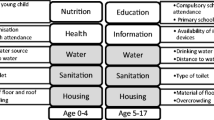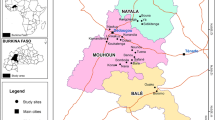Abstract
This study presents the design and development of a multidimensional child poverty index in Colombia that can be used for assessment and policy design. Using a mixed-method design that combines quantitative and qualitative research methods, we developed a multidimensional measure of child poverty. Based on these results as well as empirical evidence on deprivations that are determinant for human development, we constructed a Multidimensional Child and Adolescent Poverty Index (MCAP). We used nationally representative household survey data to estimate the MCAP for 2008, 2010 and 2011 in order to measure changes over time.
We found that overall, 34 % of children and adolescents in Colombia are living in poverty. This represents a 10 percentage-point reduction in comparison with 2008. As per the critical dimensions, we found that for all age groups lack of access to potable water, overcrowding and lack of access to parks or green areas contribute the most to child poverty. In addition, for children under five and adolescents, lack of access to education is a critical area and for children and adolescents, lack of access to recreational or time use services contribute significantly to poverty.
We show how the MCAP can be used as a policy design tool for child poverty reduction that is sensitive to the needs of children from different age groups and regions through the design of benefit packages. Both the mixed-method research design and study findings are expected to have a significant impact across sectors including both academic national and international policy circles.






Similar content being viewed by others
Notes
The ideal would be to include experts and practitioners outside Bogota. However, this was not possible because of time and resources capacity.
National Institute of Child Welfare, National Department of Social Prosperity, Ministry or Education, Ministry of Culture, Ministry of Housing, Agency for Extreme Poverty Alleviation, Early Childhood Services Commission, National Planning Department, Agency for Conciliation, UNICEF, IDB, ECLAC, UNFPA, among others.
References
Alkire, S. (2005). Why the capability approach? Journal of Human Development, 6(1), 115–135.
Alkire, S., & Foster, J. (2011). Counting and multidimensional poverty measurement. Journal of Public Economics, 95, 7–8.
Alkire, S., & Foster, J. (2011b). Understandings and misunderstandings of multidimensional poverty measurement. OPHI Working Paper, 43.
Alkire, S., & Roche, J.M. (2011). Beyond Headcount: Measures that Reflect the Breadth and Components of Child Poverty. OPHI Working Paper, 45.
Angulo, R.C., Díaz, B.Y., & Pardo, R. (2013). Multidimensional Poverty in Colombia, 1997–2010. ISER Working Paper Series, No. 2013–13.
Baker-Henninghama, H., Meeks-Gardnerb, J., Changc, S., & Walker, S. (2009). Experiences of violence and deficits in academic achievement among urban primary school children in Jamaica. Child Abuse & Neglect, 33, 269–306.
Belsky, J., & de Haan, M. (2011). Annual research review: parenting and children’s brain development: the end of the beginning. Journal of Child Psychology and Psychiatry, 52(4), 409–428.
Biggeri, M., Libanora, R., Mariani, S., & Menchini, L. (2006). Children conceptualizing their capabilities: results of a survey conducted during the first Children’s world congress on child labour. Journal of Human Development, 7(1), 59–83. doi:10.1080/14649880500501179.
Bonilla, L. (2011). Doble jornada escolar y calidad de la educación en Colombia. Documentos de trabajo sobre Economía Regional. Num 143.
Camp, W. (1990). Participation in student activities and achievement: a covariance structural analysis. Journal of Educational Research, 85(3), 272–278.
CEPAL, & UNICEF. (2010). Pobreza infantil en América Latina y el Caribe.
Chen, S., & Lu, L. (2009). After-school time use in Taiwan: effects on educational achievement and well-being. Adolescence, 44(176), 891–909.
Chen, L., & Omaye, S. T. (2001). Air pollution and health effects in northern Nevada. Reviews on Environmental Health, 16(2), 133–149.
Christie, J., & Kathleen, R. (2009). Play’s potential in early literacy development. Encyclopedia on Early Childhood Development.
Conger, R. D. R., & Conger, K. J. K. (2002). Resilience in midwestern families: selected findings from the first decade of a prospective, longitudinal study. Journal of Marriage and Family, 64, 361–373.
Darling, N. (2005). Participation in extracurricular activities and adolescent adjustment: cross-sectional and longitudinal findings. Journal of Youth and Adolescence, 34(5), 493–505.
del Mar, K. (2012). Desplazamiento Forzoso en Colombia: Evidencia sobre el Impacto en el Desarrollo Nutricional durante la Primera Infancia.
Evans, W., Kim, P., Ting, A. H., Tesher, H. B., & Shannis, D. (2007). Cumulative risk, maternal responsiveness, and Allostatic load among young adolescents. Developmental Psychology, 43(2), 341–351.
Feldman, A. F., & Matjasko, J. L. (2005). The role of school-based extracurricular activities in adolescent development: a comprehensive review and future directions. Review of Educational Research, 75(2), 159–210.
Fredricks, J. A., & Eccles, J. S. (2008). Participation in extracurricular activities in the middle school years: are there developmental benefits for African american and european american youth? Journal of Youth and Adolescence, 37(9), 1029–1043.
Gordon, D., Nandy, S., Pantazis, C., Pemberton, S., & Townsend, P. (2003). Child poverty in the develo** world. Bristol: The Policy Press.
Greene, J. C. (2005). The generative potential of mixed methods inquiry. International Journal of Research and Method in Education, 28(2), 207–211.
Hedge, N., & MacKenzie, A. (2012). Putting Nussbaum’s capability approach to work: re-visiting inclusion. Cambridge Journal of Education, 42(3), 327–344.
Hildyard, K., & Worlfe, D. (2002). Neglect: developmental issues and outcomes. Child Abuse & Neglect, 26, 679–695.
Johnson, R. B., Onwuegbuzie, A. J., & Turner, L. A. (2007). Toward a definition of mixed methods research. Journal of Mixed Methods Research, 1(2), 112–133.
Lipina, S. J., Simonds, J., & Segretin, M. S. (2011). Recognizing the child in child poverty. Vulnerable Children and Youth Studies, 6(1), 8–17.
Lovell, P. P. (2011). Reframing recreation as a public policy priority. New Directions for Youth Development, 2011(130), 141–150. doi:10.1002/yd.402.
Lundberg, M., & Wuermli, A. (Eds.). (2012). Children and Youth in Crisis: Protecting and Promoting Human Development in Times of Economic Schocks. Washington DC: World Bank.
Mathews, T., Dempsey, M., & Overstreet, S. (2009). Effects of exposure to community violence on school functioning: the mediating role of posttraumatic stress symptoms. Behaviour Research and Therapy, 47, 586–591.
Mayer, M., Lavergne, C., Tourigny, M., & Wright, J. (2007). Characteristics differentiating neglected children. Journal of Family Issues, 22, 721–732.
McLoyd, V., Purtell, K. M., Bagley, E., Hardaway, C. R., & Smalls, C. (2009). Poverty and socioeconomic disadvantage in adolescence. In R. Lerner & L. Steinbert (Eds.), Handbook of adolescent psychology (3rd ed., Vol. 2, pp. 441–491).
Morrissey, K. M., & Werner-Wilson, R. J. (2005). The relationship Betweeen out-of-school activities and positive youth development: an investigation of the influences of communities and Familiy. Adolescence, 40(157), 67–85.
Nussbaum, M. (2002). Capabilities and social justice. International Studies Review, 4(2), 123–135.
Nussbaum, M. (2003). Capabilities as fundamental entitlements: Sen and social justice. Feminist Economics, 9(2–3), 33–59.
Osofsky, J. (1999). The impact of violence on children. The Future of Children, 9(3), 33–49.
Peck, S. C., Roeser, R. W., Zarrett, N., & Eccles, J. S. (2008). Exploring the roles of extracurricular activity quantity and quality in the educational resilience of vulnerable adolescents: variable- and pattern-centered approaches. The Journal of Social Issues, 64(1), 135.
Roche, J. M. (2013). Monitoring progress in child poverty reduction: methodological insights and illustration to the case study of bangladesh. Social Indicators Research, 112(2), 363–390. doi:10.1007/s11205-013-0252-8.
Rodríguez, C., & Sánchez, F. (2012). Armed conflict exposure, human capital investments, and child labor: evidence from Colombia. Defence and Peace Economics, 23(2), 161–184.
Sale, J. E. M., & Brazil, K. (2002). Revisiting the quantitative-qualitative debate: implications for mixed-methods research. Quality and Quantity, 36, 43–53.
Sen, A. K. (1997). On economic inequality. New York: Clarendon Oxford Press.
Sen, A. (1999). Development as freedom. New York: Anchor Books.
Sen, A. K. (2004). Capabilities, lists, and public reason: continuing the conversation. Feminist Economics, 10(3), 77–80.
Shonkoff, J. P., & Levitt, P. (2010). Neuroscience and the future of early childhood policy: moving from Why to what and How. Neuron, 9, 689–691.
Shonkoff, J. P., Garner, A. S., Siegel, B. S., Dobbins, M. I., Earls, M. F., McGuinn, L., & Wood, D. L. (2012). The lifelong effects of early childhood adversity and toxic stress. Pediatrics, 129(1), e232.
Trani, J.-F., Biggeri, M., & Mauro, V. (2013). The multidimensionality of child poverty: evidence from Afghanistan. Social Indicators Research, 112(2), 391–416.
Acknowledgments
This article is part of the study “Analysis of Child Poverty in Colombia” funded by UNICEF. Authors thank Catalina Gutiérrez, Carlos Eduardo Vélez, Tomás Martín, Juan Pablo Mosquera, Edna Bautista, Paola Caro, María Fernanda Torres, Ethel Segura and Hans Cabra for their contribution in the development of the study. They also thank Olga Isabel Isaza and Jeaneth Avila from UNICEF for their comments and suggestions throughout the study.
Author information
Authors and Affiliations
Corresponding author
Appendix 1
Appendix 1
Rights and permissions
About this article
Cite this article
García, S., Ritterbusch, A. Child Poverty in Colombia: Construction of a Multidimensional Measure Using a Mixed-Method Approach. Child Ind Res 8, 801–823 (2015). https://doi.org/10.1007/s12187-014-9274-2
Accepted:
Published:
Issue Date:
DOI: https://doi.org/10.1007/s12187-014-9274-2




